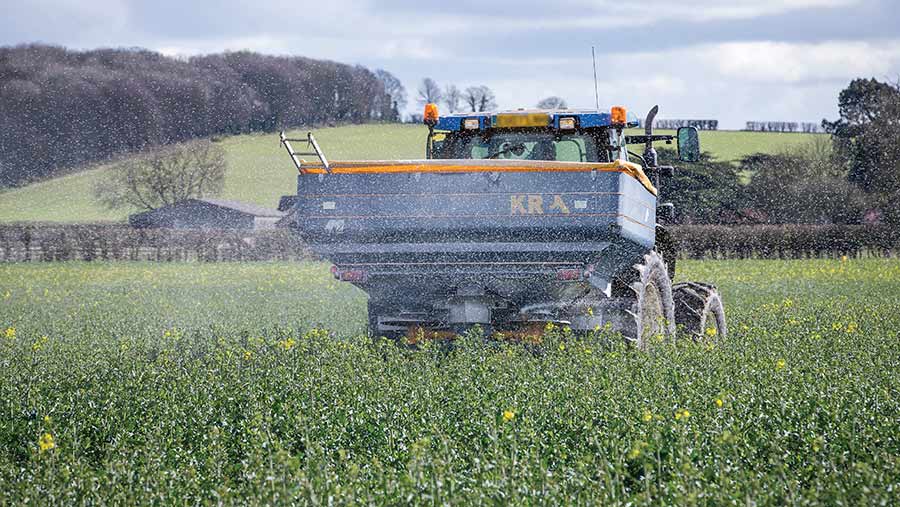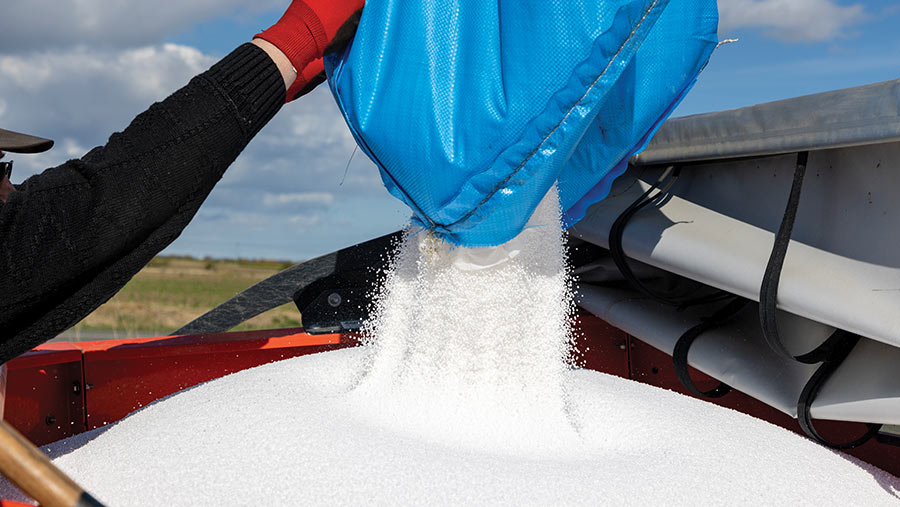Survey shows high fertiliser prices accelerated falling trend
 © GNP
© GNP Average field rates, the percentage of land dressed and overall application rates of the main nutrients fell in the 2022 harvest year on both crop and grass land.
The British Survey of Fertiliser Practice put this down largely to the sharp price rises of 2021 and 2022.
These were fuelled by the temporary closure of CF Industries UK’s Billingham ammonium nitrate plant in September 2021, followed by the Russian action in Ukraine in February 2022.
See also: Fertiliser market developments after disruption of 2022
Effects of price rise on fertiliser use
The increased cost of fertiliser had affected decision-making on mineral fertiliser use on 74% of the 1,300 farms in the survey.
The higher price led to lower nitrogen application rates on 78% of farms overall, with 83% of arable holdings cutting N rates and 77% of grassland holdings.
On the 26% of farms where price had not affected fertiliser decisions, 32% said the rise was not significant at the time when they bought their fertiliser, and 21% had sufficient stock so did not need to buy at the increased cost.
Measures taken as a result of the increased cost of manufactured fertiliser included buying product at a different time of year (15% of farms) and buying in manure (11%), while 10% had given new consideration to green manures or cover crops.
Nitrogen
Use of the main nutrients has been on a falling trend since the survey began in 1982, but the 16 kg/ha decrease in total nitrogen use on all crops and grassland in 2022 was a sharper fall than in previous years.
Cropping land saw a 12kg/ha drop in the overall application rate to 118kg/ha across all cropped land.
With 87% of that land receiving any manufactured N (down from 89% in 2021), the average field rate applied was 136kg N/ha, a drop of 11kg on the previous year.
In 2022, winter wheat, winter barley, spring barley, oilseed rape and sugar beet all recorded lower rates of manufactured N applications, with the 170kg/ha field rate for winter wheat the lowest ever observed in the survey.
The 2022 overall nitrogen rate on grassland is also the lowest ever recorded by the survey.
Just 42% of grassland had any manufactured N applied, down from 59% the previous year.
This was at an average field rate of 80kg/ha, roughly 10% lower than in 2021.
Since 2000, the overall application rates on grass have seen a significant decline, says the survey, despite a relatively steady period for about 10 years from 2009.

© GNP
Phosphate
Phosphate rates on the cropping area as a whole have declined every year since 2018 to 17kg/ha in 2022, with an average application of 49kg/ha that year, a drop of 4kg/ha.
Twenty-two percent of the cropped area received phosphate in 2022, down from 37% the previous year.
On the grassland area, the overall rate in 2022 fell by 3kg to 4kg/ha and was down 2kg/ha to 18kg/ha for the average field application, with just 22% of the area receiving a phosphate dressing.
Potash
Overall potash application rates between 2014 and 2018 were reasonably stable at 35-40kg/ha, but 2022 saw a 4kg/ha drop, to 24kg/ha.
A potash dressing was applied to 37% of the cropped area in the 2022 crop year, averaging 63kg/ha, down 1kg on the 2021 rate.
The overall potash rate on grassland decreased by 5kg/ha to 6kg/ha, with 22% of the grassland area getting a potash dressing at an average field rate of 25kg (down 3kg/ha on 2021 rates).
Sulphur
Detailed sulphur use has been collected in the survey since 1993, when only 3-6% of the cereal crop areas and 8% of the oilseed rape area received a sulphur application.
By 1997, these proportions had increased to 13-14% for cereals and 30% for oilseed rape. In 2022, sulphur dressing covers in cereals were in the 46-67% range, which was lower than in 2021.
In 2022, 30% of all crops and grass received a sulphur dressing, with 54% of crops treated and 11% of grass.
Eighty percent of 2022 winter oilseed rape got sulphur, which was just below the five-year average of 81%.
Organic fertilisers
While the survey focuses on collecting data on manufactured fertilisers, it also found that in 2022, about 67% of farms used organic manures on at least one field.
In that year, 59% of cattle manure and 90% of cattle slurry applications were made to grassland.
Spreader accuracy
Less than half of farmers checked spreader accuracy in 2022.
- 47% of farmers using a spreader for mineral fertiliser said they checked their accuracy by using catch trays on an annual basis
- 7% checked more frequently than this, at each change of fertiliser
- 25% of farmers in the survey never check their spreaders for accuracy
- 4% of farmers considered spreader accuracy did not need to be checked
Measures taken as a result of increased cost of fertiliser |
||||||
|
|
All farms |
Farms with crops |
Farms with grass |
|||
|
|
Farms (%) |
Area (%) |
Farms (%) |
Area (%) |
Farms (%) |
Area (%) |
|
Bought in manure to replace mineral fertiliser |
11% |
12% |
13% |
14% |
11% |
12% |
|
Analysed nutrient contents of any manure before using |
6% |
8% |
8% |
9% |
7% |
9% |
|
Applied digestate or manure/ slurry as a topdressing |
6% |
6% |
6% |
7% |
7% |
6% |
|
Increased the area of crops with a lower fertiliser requirement |
6% |
9% |
9% |
12% |
5% |
7% |
|
Reduced the area of crops grown |
5% |
4% |
6% |
5% |
5% |
5% |
|
Bought or introduced technology to improve efficient use of fertiliser |
6% |
7% |
8% |
9% |
5% |
6% |
|
Commenced conversion to organic |
1% |
2% |
1% |
1% |
1% |
2% |
|
Bought fertiliser at a different time of year |
15% |
17% |
18% |
20% |
13% |
16% |
|
Given new consideration to green manures/cover crops |
10% |
13% |
15% |
17% |
9% |
11% |
|
None of the above |
58% |
54% |
49% |
47% |
60% |
56% |
|
No answer |
0% |
0% |
0% |
0% |
0% |
0% |
|
Don’t know |
0% |
0% |
0% |
0% |
0% |
0% |
|
Source: British Survey of Fertiliser Practice |
||||||
Reasons why increased cost of fertiliser had not affected decisions |
||||||
|
|
All farms |
Farms with crops |
Farms with grass |
|||
|
Farms (%) |
Area (%) |
Farms (%) |
Area (%) |
Farms (%) |
Area (%) |
|
|
Good grain price and yield |
14% |
17% |
21% |
20% |
10% |
14% |
|
Rise wasn’t significant when we bought |
32% |
43% |
36% |
47% |
31% |
41% |
|
Already had stocks, didn’t need to buy |
21% |
23% |
26% |
24% |
20% |
23% |
|
None of the above |
39% |
30% |
29% |
25% |
42% |
33% |
|
No answer |
1% |
1% |
0% |
0% |
2% |
1% |
|
Don’t know |
1% |
0% |
1% |
0% |
1% |
0% |
|
Source: British Survey of Fertiliser Practice |
||||||
About the survey
The annual British Survey of Fertiliser Practice is funded by Defra and the Scottish government.
It aims to survey 1,500 farmers by interview and in 2022 received responses from just over 1,300 farmers.
The survey data provide evidence to assess greenhouse gas emissions from agriculture, helping to inform ammonia and greenhouse gas inventories and for the development of possible mitigation measures.
They are also used for developing and assessing the effects of policy on water quality and the environment and for indicators on nutrient balances.
Other uses relate to environmental impacts and other work, looking at links between fertiliser use, productivity (benchmarking) and economic performance.
The detailed survey is available on the government website.
